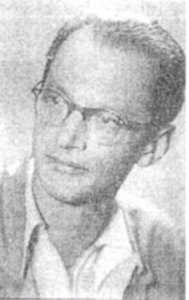
Janusz Andrzej Tyman,
a.k.a. "Dzigan"
XXII Home Army district (Żoliborz)
"Żbik" group
platoon 233
The Witnesses' Uprising Reports
"It was like that ..." - The Warsaw Uprising 1944 on Żoliborz

Janusz Andrzej Tyman,
a.k.a. "Dzigan"
XXII Home Army district (Żoliborz)
"Żbik" group
platoon 233
I am not a native Warsawian. I was born in one of the most beautiful Polish cities - Vilnius. In the thirties of the previous century my parents (with me, certainly) moved into Warsaw. My father must have had a feeling that something like The situation that occurred on September 17, 1939 might have happened. This protected him against a meeting with our "ex-older brothers" but did not from a meeting with "Lords" wearing cups with skulls. He was arrested by the Gestapo in the first half of the year 1940 - unfortunately we didn't see him anymore.
My underground activity was very poor. At the very beginning, in March 1943 I was arrested by the Gestapo. It happened with "honours" when a special committee from Aleja Szucha arrived to get me in Żoliborz (I used to live in the Mickiewicza street then). I was on the Pawiak till a moment when in July 1944 the Germans started to leave Warsaw quickly. The Pawiak was made clean by three groups of prisoners. Probably, they were formed mechanically - some prisoners were brought to the ghetto where they were shot; The second group were directed to The transport to another prisons and camps in Germany. The last group was just made free. I was lucky to be in this last group. I reached my home on July 28, 1944. After doming back from the Pawiak, I was ill and stayed in bed.
August 1 - some shots are heard - German armoured vehicles start to cross the Mickiewicza street.
August 2 - silence.
August 3 - my neighbour rushes the house - a little boy about 10 years old:
- Mr. Janusz, something's going on. The Germans patrol the streets around us, Inwalidów Square, Wojska Polskiego Avenue; running figures wearing white and red armbands are seen. - What's going on?
On the next day, despite not best state of my Heath, I'm going to see what's happening. I reach a mobilization point in the Krasińskiego 18 - I'm not returning home - I got an order to join 222nd platoon of "Żyrafa" ("Giraffe") group.
In the next few days here is an reorganisation of Żoliborz area. Platoon 222 is moved to "Żyrafa II" ("Giraffe II") group, which changes a name for "Żbik" ("Wildcat") group and I become a soldier of platoon 222 of this group. I stay in "Żbik"("Wildcat") till the end of the Rising.
***
District II of the Home Army during the German occupation, District XXII of the Home Army during The Warsaw Uprising, infantry Division 8 of the Home Army named after Romuald Traugutt from a moment of creating in September 1944 the Warsaw Corps of the Home Army - were all commanded by Lieutenant Colonel Mieczysław Niedzielski a.k.a.: "Boruta", "Papuga" ("Parrot"), "Sadownik" ("Orchardist") and during the Rising "Żywiciel" ("Breadwinner"). He was the one who ordered all the groups of District XXII fighting in Żoliborz to create cryptonyms starting with a letter "Ż" and the groups' commanders to get pseudonyms in lieu with the group name. There were six such groups:
- "Żaglowiec" ("Saling ship"), commander: Captain Marian Kamiński a.k.a. "Jur", "Ster" ("Rudder"), "Żaglowiec" ("Sailing ship")
- "Żmija" ("Viper"), commander: Captain of horse Adam Rzeszotarski a.k.a. "Junosza", "Sum" ("Catfish"), "Żmija" ("Viper")
- "Żbik" ("Wildcat"), commander: Captain Witold Plechawski a.k.a. "Sławomir", "Żbik" ("Wildcat")
- "Żniwiarz" ("Harvester"), commander: Lieutenant Mieczysław Morawski a.k.a. "Szeliga", "Żniwiarz" ("Harvester")
- "Żubr" ("Bison"), commander: Major Władysław Nowakowski a.k.a. "Serb", "Żubr" ("Bison")
- "Żyrafa" ("Giraffe"), commander: Captain Kazimierz Nowacki a.k.a. "Witold", "Szkodnik" ("Pest"), "Żyrafa" ("Giraffe").
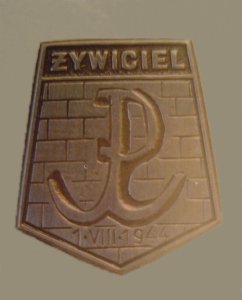
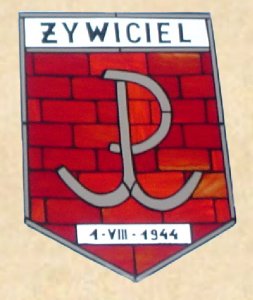
"Żywiciel" ("Breadwinner") group
The District included the following services: sanitary, liaison, weapons, work of a gunsmith, sappers and others. One would estimate that there were about 2,200 soldiers in the District. About 60% of them, i.e. about 1,200 soldiers of the Home Army were ready to fight on August 1, at "W" hour. During the underground actions this number would change constantly. New volunteers came from Żoliborz and other districts. According to the documents and information we have, about 4,500 soldiers of the Home Army who took part in fightings with the occupier passed through Żoliborz.
The northern part of Żoliborz included during the occupation and the Rising Żoliborz and Marymont, Bielany and Powązki. Żoliborz was separated from the central part of the city by Gdański railway station's tracks those siding separated Żoliborz from Powązki.
Communication between Żoliborz and the Rest of The city was possible only through two streets - a flyover above Gdański railway station, coming into the Bonifraterska street and through Wisłostrada. These two connections were controlled by the Citadel built in the 19th century by the Tsarist Russia and now heavily filled by the Germans. Between Powązki and Żoliborz here was a paving track crossing the siding tracks, during The Rising also under The German control holding by an armoured train that used to run there and shell Żoliborz, especially a Convent of the Nuns of the Christ Resurrection (Siostry Zmartwychwstania Pańskiego) in the Krasińskiego street (currently the Fr. Jerzego Popiełuszki street).
From west and north The Germans filled the Chemical Institute, the school in the Kolektorska street, CIF (currently AWF - Academy of Physical Education) and the Gas School in the Gdańska street (currently the Dembowskiego street's neighbourhood).
The eastern order of Żoliborz was The Vistula river which was freely accessible during the whole period of the Rising. But on September 30, when the soldiers from "Żywiciel" ("Breadwinner") group were to go to the Praga bank, the Vistula embankment was heavily filled by The Germans.
The Rising in Żoliborz broke out much earlier than the orders said. At 1.30 p.m. in The Krasińskiego street in the area of Wilson Square here was a clash between the patrol of 9 diversionary company and the patrol of German aviators. According to a plan at 5 p.m. ("W" hour) the following points of resistance were to be attacked and filled: the Citadel, Traugutt Fort, the Legions Fort and Gdański railway station. From west: the Chemical Institute, Bem Fort, Boernerowo and the area of cannons in Buraków. From north: the Central Institute of Physical Education, Bielany airport, "Waldlager" (forest camp) and the Gas School in Marymont.
A little fight that started at 1.30 p.m. made the Germans ready to ward off the expected attacks. Tank appeared, as well. That is why offensives of the insurgents were fought back in a bloody way. In the evening on August 1 the District Commander made a decision to withdraw to Puszcza Kampinoska, having estimated that there was no chance to further fighting. About the midnight the District units (about 1,000 soldiers) left Żoliborz, withdrawing at the axis Laski - Sieraków. Before leaving Lieutenant Colonel Żywiciel reported to the District Commandant on the decision and asked for further orders. In the morning hours on August 2 the District Commandant made a liaison officer, that brought a report, Come back to Żoliborz and further to Puszcza Kampinoska and pass on the order to immediate return to deserted positions. (The liaison officer reached Lieutenant Colonel Żywiciel in the evening hours in Sieraków). The return way was not easy. On the colony "Working-class' Loot" on August 3 the Żywiciel soldiers had to heavily fight for several hours with the Germans in order to gain a way to the centre of Żoliborz.
Żoliborz was not deserted for those several days, though. In the area of Wilson Square and at the axis of the Mickiewicza street in the direction of the Potocka street small groups of soldiers from the "Żmija" ("Viper") group together with their commander stayed. In the area of the Suzina street in the direction of the Słowackiego and Potocka streets, as well as Wilson Square platoons OW PPs stayed. In the area of Inwalidów Square groups of soldiers from the Niagara group stayed.
On August 4 Lieutenant Colonel Niedzielski together with his soldiers reached the central Żoliborz. On the next day he reorganized the whole District II and ordered the units' redeployment.
At the end of August (August 20 and 21) serious fights aimed at the connection between Żoliborz and the Old Town occurred. Guerrilla units from Puszcza Kampinoska and Puszcza Nalibocka arrived in order to help the Żoliborz soldiers. After an unsatisfactory action in the Gdański railway station these units withdrew to Puszcza Kampinoska. Some number of soldiers, though, stayed in Żoliborz, joining the Żoliborz groups.
"Żaglowiec" ("Saling ship") group on its war route fought for the Citadel, Traugutt Forts, The Legions' Fort, in the Zajączka street, "Poniatówka" Gymnasium and the whole Officer Żoliborz, not to mention the fightings in Gdański railway station.
A war route of "Żbik" ("Wildcat") group: Powązki, The Content of Zmartwychwstanki - its popular name is fortress of Zmartwychwstanki Nuns and Low Żoliborz.
A war router of "Żmija" ("Viper") group: Marymont, Working-class' Loot, taking part in fightings in Gdański railway station and Opel garages as well as Fire Station (school).
A war route of "Żniwiarz" ("Harvester") came along Suzina street (9 diversionary company) through Working-class' Loot and taking part in fightings in Gdański railway station and defence of Opel garages as well as heavy fights in the last days of the Rising in the area of Słowackiego street and Wilson Square.
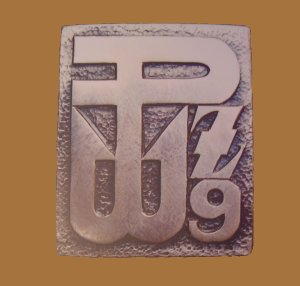
"Żniwiarz" ("Harvester") group
A war router of "Żubr" ("Bison") group came along Bielany, Puszca Kampinoska, fight in Babice (August 2), return to Marymont - fightings in the Kolektorska street and in Oil Factory.
A war router of "Żyrafa" ("Giraffe") group: Wojska Polskiego Avenue, the Stołeczna street (currently the Fr. Jerzego Popiełuszki street), Henkla Square and the Convent of Zmartwychwstanki Nuns.
An advanced attack of the 19 German Low Saxon armoured division from a west and north side on September 28 and 29 made the "Żywiciel" ("Breadwinner") units withdraw in such a way that on September 30 we could fill only the area from the eastern side of the Słowackiego street till the Vistula enbankment and in the direction north - south limited by the Potocka street and Wilson Square.
The Żoliborz capitulation was signed in the late afternoon hours on September 30, 1944.
After signing the capitulation Lieutenant Colonel Żywiciel was taken away on stretchers (he was wounded twice) and sent to a prisoner camp in Altengrabow and then to a camp in Sandbostel. In the latter, in April 1945, together with a group of the Home Army officers, he was arrested by the Gestapo and taken away to a concentration camp in Neuengamme. A pretext for the arrest was an alleged plot aimed at capturing an officer camp in Sandbostel. A true reason for this Gestapo action was probably a willingness to take revenge for the Warsaw Uprising.
As for Lieutenant Colonel Żywiciel there were a lot of reasons. General Von dem Bach testified in 1946 the International War Tribunal in Norymberg, "I would like to pay attention to the Commander of the Żoliborz District. I could not start the negotiations with him at all. Each of his answers was insulting for me. He was a Hero. This man was a fanatic." (An answer of Lieutenant Colonel Żywiciel for a capitulation proposal was a well known one - Please do, we are ready for adopting a capitulation of Germany, please store our weapons on Wilson Square). What saved the arrested officers from death in the concentration camp was the intervention of the Swedish Red Cross by Heinrich Himmler, at the result of which the officers were moved to a prisoner camp in Lubeka.
Janusz Andrzej Tyman
Translated by Monika Ałasa
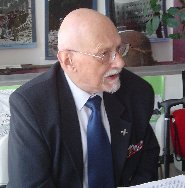
|
Janusz Andrzej Tyman, a.k.a. Dzigan District XXII of The Home Army (Żoliborz) "Żbik" group platoon 233 |
Copyright © 2004-2005 Maciej Janaszek-Seydlitz. Wszelkie prawa zastrzeżone.